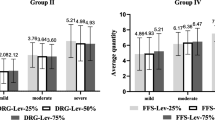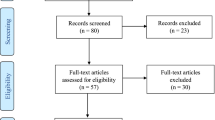Abstract
Methods of paying health providers have been extensively studied in health economics. Bonus as a powerful incentive has been widely used to boost staff morale and improve productivity in hospitals. This may, however, also create unintended consequences. This study analyzes primary data collected from a physician survey in China and demonstrates that the extensive use of quantity-based bonuses has not only led to the provision of unnecessary care but also crowded out physician’s intrinsic motivations, resulting in a decline in the quality of services. More appropriate physician remuneration mechanisms must be introduced in China’s ongoing health reform.
Similar content being viewed by others
References
Aoki, N., et al. (2008). Impact of miscommunication in the medical dispute cases in Japan. International Journal for Quality in Health Care, 20(5), 358–362.
B’enabou, R., & Tirole, J. (2003). Intrinsic and extrinsic motivation. Review of Economic Studies, 70, 489–520.
Barnum, H., Kutzin, J., & Saxenian, H. (1995). Incentives and provider payment methods. International Journal of Health Planning and Management, 10(1), 23–45.
Bloom, G., Han, L., & Li, X. (2001). How health workers earn a living in China. Human Resources for Health Development Journal, 5(1–3), 25–38.
Cho, H. S., et al. (1998). Reasons why patients and families choose medical disputes. Journal of the Korean Academy of Family Medicine, 19(3), 274–291.
Currie, J., Lin, W., & Zhang, W. (2011). Patient knowledge and antibiotic abuse: evidence from an audit study in China. Journal of Health Economics, 30(5), 933–949.
Dor, A., & Watson, H. (1995). The hospital-physician interaction in US hospitals: evolving payment schemes and their incentives. European Economic Review, 39, 795–802.
Duckett, J. (2011). The Chinese State’s retreat from health: policy and the politics of retrenchment. London: Routledge.
Eggleston, K., et al. (2008). Health service delivery in China: a literature review. Health Economics, 17, 149–165.
Ellis, R. P., & McGuire, T. G. (1990). Optimal payment systems for health services. Journal of Health Economics, 9(4), 375–396.
Ellis, R. P., & McGuire, T. G. (2006). Provider behavior under prospective reimbursement. Cost sharing and supply. Journal of Health Economics, 5(2), 129–51.
Feess, E., & Ossig, S. (2007). Reimbursement schemes for hospitals, malpractice liability, and intrinsic motivation. International Review of Law and Economics, 27, 423–441.
Feng, J., et al. (2013). A retrospective analysis on 418 medical disputes. Chinese Hospital Management, 33(9), 77–79 in Chinese.
Frey, B. S., & Jegen, R. (2001). Motivation crowding theory. Journal of Economic Surveys, 15(5), 589–611.
Gabel, J. R., & Redisch, M. A. (1979). Alternative physician payment methods: incentives, efficiency, and national health insurance. Milbank Quarterly, 57(1), 38–59.
Greiner, A. C., & Knebel, E. (2003). Health professions education: a bridge to quality. Washington DC: National Academics Press.
Harris, J. E. (1977). The internal organization of hospitals: some economic implications. Bell Journal of Economics, 8, 467–482.
He, J. A. (2014). The doctor-patient relationship, defensive medicine and overprescription in Chinese public hospitals: evidence from a cross-sectional survey in Shenzhen City. Social Science and Medicine, 123, 64–71.
He, J. A., & Qian, J. (2013). Hospitals’ responses to administrative cost-containment policy in urban China: the case of Fujian Province. China Quarterly, 216, 946–969.
He, J. A., & Qian, J. (2016). Explaining medical disputes in Chinese public hospitals: the doctor-patient relationship and its implications for health policy reforms. Health Economics, Policy, and Law. doi:10.1017/S1744133116000128.
He, J. A., & Yang, W. (2015). Clinical pathways in China: an evaluation. International Journal of Health Care Quality Assurance, 28(4), 394–411.
Heckman, H. B., et al. (1994). The doctor-patient relationship and malpractice: lessons from plaintiff depositions. Archives of Internal Medicine, 154(12), 1365–1370.
Hickson, G. B., et al. (1992). Factors that prompted families to file medical malpractice claims following perinatal injuries. Journal of the American Medical Association, 267(10), 1359–1363.
Howie, J. R. G., et al. (1991). Long to short consultation ratio: a proxy measure for quality of care for general practice. British Journal of General Practice, 41(343), 48–54.
Hsiao, W. C. (1995). The Chinese health care system: lessons for other nations. Social Science and Medicine, 41(8), 1047–1055.
Hsiao, W. C. (2008). When incentives and professionalism collide. Health Affairs, 27(4), 949–951.
Jegers, M., Kesteloot, K., De Graeve, D., & Gilles, W. (2002). A typology of provider payment systems in health care. Health Policy, 60(3), 255–273.
Jian, W., & Guo, Y. (2009). Does per-diem reimbursement necessarily increase length of stay? The case of a public psychiatric hospital. Health Economics, 18(S2), 97–106.
Kao, A. C., et al. (1998). The relationship between method of physician payment and patient trust. JAMA, 280(19), 1708–1714.
Kwon, S. M. (2003). Payment system reform for health care providers in Korea. Health Policy and Planning, 18(1), 84–92.
Lancet (2010). Chinese doctors are under threat (editorial). The Lancet, 376(9742), 657.
Lancet (2014). Violence against doctors: why China? Why now? What next? (editorial). The Lancet, 383(9922), 1013.
Levinson, W., et al. (1997). Physician-patient communication: the relationship with malpractice claims among primary care physicians and surgeons. Journal of the American Medical Association, 277(7), 553–559.
Li, Y., et al. (2012). Overprescribing in China: driven by financial incentives, results in very high use of antibiotics, injections and corticosteroids. Health Affairs, 31(5), 1075–1082.
Lim, M. K., et al. (2004). China’s evolving health care market: how doctors feel and what they think. Health Policy, 69(3), 329–337.
Liu, X., & Mills, A. (2003). The influence of bonus payments to doctors on hospital revenue: results of a quasi-experimental study. Applied Health Economics and Health Policy, 2(2), 91–98.
Liu, X., & Mills, A. (2005). The effect of performance-related pay of hospital doctors on hospitak behavior: a case study from Shandong, China. Human Resources for Health, 3(11), 1–12.
Liu, X., Liu, Y., & Chen, N. (2000). The Chinese experience of hospital price regulation. Health Policy and Planning, 15(2), 157–163.
Neveloff, E. E., & Dubler, N. (1995). Preserving the physician-patient relationship in the era of managed care. JAMA, 4, 323–329.
Pei, L., Legge, D., & Stanton, P. (2000). Policy contradictions limiting hospital performance in China. Policy Studies, 21(2), 99–113.
Reynolds, L. & McKee, M. (2009). Factors influencing antibiotic prescribing in China: an exploratory analysis. Health Policy, 90(1), 32–36.
Rice, N., & Smith, P. C. (2001). Capitation and risk adjustment in health care financing: an international progress. Milbank Quarterly, 79(1), 81–113.
Robinson, J. C. (2001). Theory and practice in the design of physician payment incentives. Milbank Quarterly, 79(2), 149–177.
Roemer, M. I. (1962). On paying the doctor and the implications of different methods. Journal of Health and Human Behavior, 3(1), 4–14.
Rosenthal, M. B. (2008). Beyond pay for performance: emerging models of provider-payment reform. New England Journal of Medicine, 359, 1197–1200.
Rosenthal, M. B. et al. (2004). Paying for quality: providers’ incentives for quality improvement. Health Affairs, 23(2), 127–141.
Rossner, R. M. (2013). Medical liability and the doctor-patient relationship in China. China Medical Board Reports, September 30, available at http://www.chinamedicalboard.org/sites/chinamedicalboard.org/files/rossner30sept13.pdf.
Sarma, S., Devlin, R. A., Belhadji, B., & Thind, A. (2010). Does the way physicians are paid influence the way they practice? The case of Canadian family physicians’ work activity. Health Policy, 98(2–3), 203–217.
Shortell, S. M., Gillies, R. R., Anderson, D. A., & Erickson, K. M. (1996). Remaking health Care in America: building organized delivery system. San Francisco: Jossey-Bass Publishers.
Sloan, F. A. & Hsieh, C. R. (2012). Health Economics. Boston: MIT Press.
Tam, W. K. (2010). Privatizing health care in China: problems and reforms. Journal of Contemporary China, 40(1), 63–81.
Wang, H., et al. (2010). An experiment in payment reform for doctors in rural China reduced some unncessary care but did not lower total costs. Health Affairs, 30(11), 2427–2436.
Williams, S. J., & Calnan, M. (1991). Key determinants of consumer satisfaction with general practice. Family Medicine, 8(3), 237–242.
Williams, E. S., & Skinner, A. C. (2003). Outcomes of physcian job satisfaction: a narrative eeview, implications and directions for future research. Health Care Management Review, 28(2), 119–139.
Wranik, D. W., & Durier-Copp, M. (2010). Physician remuneration methods for family physicians in Canada: expected outcomes and lessons learned. Health Care Analysis, 18(1), 35–59.
Wu, D., et al. (2014). Health system reforms, violence against doctors and job satisfaction in the medical profession: a cross-sectional survey in Zhejiang Province. Eastern China. BMJ Open, 4. doi:10.1136/bmjopen-2014-006431.
Wynia, M. K. (2009). The risks of rewards in health care: how pay-for-performance could threaten, or bolster, medical professionalism. Journal of General Internal Medicine, 24(7), 884–887.
Yip, W., & Hsiao, W. C. (2008). The Chinese health system at a crossroads. Health Affairs, 27(2), 460–468.
Yip, W. et al. (2010). Realignment of incentives for health-care providers in China. The Lancet, 375(9720), 1120–1130.
Yip, W., et al. (2014). Capitation combined with pay-for-performance improves antibiotic prescribing practices in rural China. Health Affairs, 33(3), 502–510.
Zheng, X., & Hillier, S. (1995). The reforms of the Chinese health care system: county level changes: the Jiangxi study. Social Science and Medicine, 41, 1057–1064.
Zhong, J. (2001). Influencing factors on medical quality and measures for management. Chinese Journal of Hospital Management, 17(9), 536–548 in Chinese.
Acknowledgments
This study was funded by the Early Career Scheme of the Research Grants Council (Ref. ECS859213), the Hong Kong SAR Government and the Dean’s Research Fund (Ref. ECR2) of the Faculty of Liberal Arts and Social Science, the Education University of Hong Kong. The authors are thankful to Lu Zhang, Luke Yuankun Luo, Jieyi Luo, and Mandy Sin-Man Wong for excellent assistance in data collection and entry. Constructive comments from Chung-An Chen and anonymous reviewers are gratefully acknowledged.
Author information
Authors and Affiliations
Corresponding author
Rights and permissions
About this article
Cite this article
Qian, J., He, A.J. The Bonus Scheme, Motivation Crowding-out and Quality of the Doctor-Patient Encounters in Chinese Public Hospitals. Public Organiz Rev 18, 143–158 (2018). https://doi.org/10.1007/s11115-016-0366-y
Published:
Issue Date:
DOI: https://doi.org/10.1007/s11115-016-0366-y




